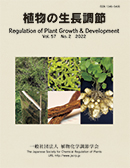57 巻, 2 号
選択された号の論文の11件中1~11を表示しています
- |<
- <
- 1
- >
- >|
特集: 植物特化代謝の合成生物学
-
原稿種別: 特集:植物特化代謝の合成生物学
2022 年 57 巻 2 号 p. 75-76
発行日: 2022年
公開日: 2024/01/04
PDF形式でダウンロード (361K) -
原稿種別: 特集:植物特化代謝の合成生物学
2022 年 57 巻 2 号 p. 77-83
発行日: 2022年
公開日: 2024/01/04
PDF形式でダウンロード (1419K) -
原稿種別: 特集:植物特化代謝の合成生物学
2022 年 57 巻 2 号 p. 84-92
発行日: 2022年
公開日: 2024/01/04
PDF形式でダウンロード (1998K) -
原稿種別: 特集:植物特化代謝の合成生物学
2022 年 57 巻 2 号 p. 93-99
発行日: 2022年
公開日: 2024/01/04
PDF形式でダウンロード (934K) -
原稿種別: 特集:植物特化代謝の合成生物学
2022 年 57 巻 2 号 p. 100-107
発行日: 2022年
公開日: 2024/01/04
PDF形式でダウンロード (3101K) -
原稿種別: 特集:植物特化代謝の合成生物学
2022 年 57 巻 2 号 p. 108-113
発行日: 2022年
公開日: 2024/01/04
PDF形式でダウンロード (2147K)
総説
-
原稿種別: 総説
2022 年 57 巻 2 号 p. 114-122
発行日: 2022年
公開日: 2024/01/04
PDF形式でダウンロード (1191K) -
原稿種別: 総説
2022 年 57 巻 2 号 p. 123-130
発行日: 2022年
公開日: 2024/01/04
PDF形式でダウンロード (1807K)
研究ノート
-
原稿種別: 研究ノート
2022 年 57 巻 2 号 p. 131-136
発行日: 2022年
公開日: 2024/01/04
PDF形式でダウンロード (2783K) -
原稿種別: 研究ノート
2022 年 57 巻 2 号 p. 137-140
発行日: 2022年
公開日: 2024/01/04
PDF形式でダウンロード (3292K)
談話室
-
原稿種別: 談話室
2022 年 57 巻 2 号 p. 141-144
発行日: 2022年
公開日: 2024/01/04
PDF形式でダウンロード (3488K)
- |<
- <
- 1
- >
- >|
